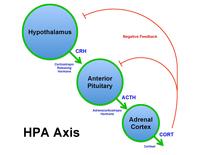
Photo from wikipedia
This study aimed to find out cellular and electrophysiological effects of the edaravone (EDR) administration following induction of vascular dementia (VaD) via bilateral-carotid vessel occlusion (2VO). The rats were randomly… Click to show full abstract
This study aimed to find out cellular and electrophysiological effects of the edaravone (EDR) administration following induction of vascular dementia (VaD) via bilateral-carotid vessel occlusion (2VO). The rats were randomly divided into control, sham, 2VO + V (vehicle), and 2VO + EDR groups. EDR was administered once a day from day 0-28 after surgery. The passive-avoidance, Morris water-maze, and open-field tests were used for evaluation of memory, locomotor, and anxiety. The field-potential recording was used for assessment of electrophysiological properties of the hippocampus; and after sacrificing, the cerebral hemispheres were removed for stereological study and evaluation of MDA levels. The long-term potentiation (LTP), paired-pulse ratio (PPR), and input-output (I/O) curves were evaluated as indexes for long-term and short-term synaptic plasticity, and basal-synaptic transmission (BST), respectively. The 2VO led to increases in MDA level with considerable neuronal loss and decreases in the volume of the hippocampus, along with a reduction in the BST and LTP induction which was associated with a decrement in PPR and ultimate loss in memory with higher anxiety behavior. However, administration of EDR caused a decline in MDA and prevented the neural loss and volume of the hippocampus, rescued BST and LTP depression, improved memory and anxiety without any effects on PPR. Therefore, most likely through the improvement of MDA level, and the hippocampal cell number and volume, EDR leads to recovery of synaptic plasticity and behavioral performance. Because of the LTP rescue, without recovery of PPR, it is likely that the EDR improved LTP through the post-synaptic neurons.
Journal Title: Brain Research Bulletin
Year Published: 2021
Link to full text (if available)
Share on Social Media: Sign Up to like & get
recommendations!